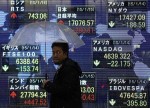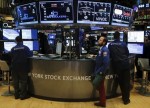
- All Instrument Types
- Indices
- Equities
- ETFs
- Funds
- Commodities
- Currencies
- Crypto
- Bonds
- Certificates
Please try another search

ETFs To Watch On Oil Price Rise And Debt Limit Deal

In a landmark deal, President Donald Trump sided with the Democrats to increase the debt limit and fund the government till mid-December. Republicans had earlier rejected this proposal by the Democrats. Trump unexpectedly agreed to the deal disappointing fellow Republicans, who were pushing for a longer extension.
Debt Limit Deal
In a meeting with Democratic Senate Minority Leader Chuck Schumer and House Minority Leader Nancy Pelosi, Trump passed the deal to back a short-term debt ceiling extension to fund the government till Dec 15, 2017 and bundle a relief package for Hurricane Harvey victims.
House speaker Paul Ryan accused the Democrats of playing “politics” with the debt ceiling and stated that a short-term extension would provide them with immense leverage over the Republicans. He also said that a faster recovery from Harvey would be doubtful with such a deal.
Trump’s dealmaker title is being doubted by the markets now. Not only did he accept the short-term, debt-ceiling plan proposed by the Democrats, he also stated that he wanted to legalize the DACA program working closely with the opposition. The DACA program, which the Trump administration aims to phase out in six months, protects young immigrants who were brought to the United States by their parents and allows them to work in the United States.
Energy Stocks Rally
The energy sector of the S&P 500 saw strong gains as oil prices increased. Oil prices rose as refineries along the Gulf coast reopened after being shut due to the disastrous Hurricane Harvey. The hurricane had led to blocking 20% of the oil refining capacity of the United States (read: ETFs to Watch in Harvey Aftermath & New Hurricane Irma).
Even before any respite could be felt from Harvey, Hurricane Irma made a landfall on the Caribbean and Hurricane Jose started forming in the Atlantic, threatening Americans of a double whammy. Moreover, Hurricane Katia has developed in the Gulf of Mexico. It might further lead to an increase in energy stocks if refineries are hit (read: Hurricane Irma: ETF Winners & Losers).
Let us now discuss a few ETFs focused on providing exposure to U.S. equities.
SPDR S&P 500 ETF (NYSE:SPY) (AX:SPY)
This fund is the most popular ETF traded in the U.S. markets. It seeks to provide exposure to the largest and most-stable companies and tracks the S&P 500 index.
It has AUM of $238.25 billion and charges a fee of 9 basis points a year. From a sector look, the fund has high exposure to Information Technology, Health Care and Financials with 23.38%, 14.64% and 14.05% allocation, respectively (as of September 5, 2017). The fund’s top three holdings are Apple Inc (NASDAQ:AAPL) , Microsoft Corporation (NASDAQ:MSFT) and Facebook Inc (NASDAQ:FB) with 4.01%, 2.70% and 1.92% allocation, respectively (as of Sep 5, 2017). The fund has returned 12.58% in a year and 9.47% year to date (as of Sep 6, 2017). It currently has a Zacks ETF Rank #3 (Hold) with a Medium risk outlook.
iShares Core S&P 500 ETF IVV
This fund is a low-cost ETF that seeks to provide exposure to large, established U.S. companies and tracks the S&P 500 index.
It has AUM of $124.98 billion and charges a fee of 4 basis points a year. From a sector look, the fund has high exposures to Information Technology, Health Care and Financials with 23.30%, 14.61% and 14.01% allocation, respectively (as of September 5, 2017). The fund’s top three holdings are Apple Inc, Microsoft Corporation and Facebook Inc with 4.0%, 2.69% and 1.91% allocation, respectively (as of Sep 5, 2017). The fund has returned 12.84% in a year and 9.72% year to date (as of Sep 6, 2017). It currently has a Zacks ETF Rank #2 (Buy) with a Medium risk outlook.
Energy Select Sector SPDR Fund XLE
This fund is the most popular ETF traded in U.S. markets providing exposure to energy companies.
It has AUM of $14.94 billion and charges a fee of 14 basis points a year. From a sector look, the fund has exposures to Oil, Gas & Consumable Fuels and Energy Equipment & Services with 84.08% and 15.92% allocation, respectively (as of June 30, 2017). The fund’s top three holdings are Exxon Mobil Corp (NYSE:XOM) , Chevron Corp (NYSE:CVX) and Schlumberger Ltd (NYSE:SLB) with 22.35%, 17.31% and 7.54% allocation, respectively (as of Sep 6, 2017). The fund has lost 7.87% in a year and 14.70% year to date (as of Sep 6, 2017). It currently has a Zacks ETF Rank #4 (Sell) with a High risk outlook.
Vanguard Energy ETF (NYSE:XLE) VDE
This fund seeks to provide exposure to energy equities in U.S. markets.
It has AUM of $4.4 billion and charges a fee of 10 basis points a year. From a sector look, the fund has exposure to Integrated Oil & Gas, Oil & Gas Exploration & Production and Oil and Gas Equipment & Services with 39.80%, 26.80% and 14.20% allocation, respectively (as of Jul 31, 2017). The fund’s top three holdings are Exxon Mobil Corp, Chevron Corp and Schlumberger Ltd with 22.0%, 14.4% and 6.7% allocation, respectively (as of Jul 31, 2017). The fund has lost 16.50% in a year and 9.40% year to date (as of Sep 6, 2017). It currently has a Zacks ETF Rank #4 with a High risk outlook.
Want key ETF info delivered straight to your inbox?
Zacks’ free Fund Newsletter will brief you on top news and analysis, as well as top-performing ETFs, each week. Get it free >>
Facebook, Inc. (FB): Free Stock Analysis Report
Apple Inc. (AAPL): Free Stock Analysis Report
Microsoft Corporation (MSFT): Free Stock Analysis Report
SPDR-SP 500 TR (SPY): ETF Research Reports
SPDR-EGY SELS (XLE): ETF Research Reports
ISHARS-SP500 (IVV): ETF Research Reports
VIPERS-ENERGY (VDE): ETF Research Reports
Schlumberger N.V. (SLB): Free Stock Analysis Report
Chevron Corporation (CVX): Free Stock Analysis Report
Exxon Mobil Corporation (XOM): Free Stock Analysis Report
Original post
Zacks Investment Research
Related Articles

Tesla (NASDAQ:TSLA) (NYSE: TSLA), the electric vehicle giant, has recently experienced a significant drop in its stock value, which has fallen nearly 45% since December. This...

Through many years of frustration among gold bugs due to the failure of gold stock prices to leverage the gold prices in a positive way, there were very clear reasons for that...

I know there is the smell of fear in the air when I see my readership double as we reach a point where weekly chart factors come into play. Up until last week, markets have...
Are you sure you want to block %USER_NAME%?
By doing so, you and %USER_NAME% will not be able to see any of each other's Investing.com's posts.
%USER_NAME% was successfully added to your Block List
Since you’ve just unblocked this person, you must wait 48 hours before renewing the block.
I feel that this comment is:
Thank You!
Your report has been sent to our moderators for review





Add a Comment
We encourage you to use comments to engage with other users, share your perspective and ask questions of authors and each other. However, in order to maintain the high level of discourse we’ve all come to value and expect, please keep the following criteria in mind:
Enrich the conversation, don’t trash it.
Stay focused and on track. Only post material that’s relevant to the topic being discussed.
Be respectful. Even negative opinions can be framed positively and diplomatically. Avoid profanity, slander or personal attacks directed at an author or another user. Racism, sexism and other forms of discrimination will not be tolerated.
Perpetrators of spam or abuse will be deleted from the site and prohibited from future registration at Investing.com’s discretion.